Do you have a question about the Kenmore 153.331762 and is the answer not in the manual?
Identifies safety symbols, general warnings, and understanding safety messages for injury prevention.
Defines terms like Qualified Technician, Service Agency, and Gas Supplier for proper understanding.
Warns about flammable materials, ignition sources, and potential explosions from gas.
Alerts to severe burn risk from hot water, especially for vulnerable groups.
Highlights hazards from improper ventilation and lack of air for combustion.
Advises on preventing damage from leaks, improper installation, and flammable vapors.
Details the 12-year limited warranty for parts and tank leaks in residential use.
Covers free labor for parts or replacement within the first year of purchase.
Provides contact information and states warranty applicability within the United States.
Introduces Master Protection Agreements for extended coverage and benefits.
Emphasizes following instructions and local codes for safe installation and placement.
Notes specific installation requirements for these states.
Warns that moving the heater requires two or more people to prevent injury.
Lists necessary materials like drain pans and expansion tanks for installation.
Enlists common tools such as pipe wrenches and screwdrivers for installation tasks.
Details tools required for sweat soldering connections, like torches and cutters.
Identifies key parts and connections of the gas water heater for installation.
Illustrates the layout of water, gas, and vent connections for proper setup.
Provides step-by-step instructions for safely disconnecting and removing the existing unit.
Details procedures for turning off water and gas supply before removal.
Explains how to disconnect vent pipes and water/gas piping from the unit.
Instructs on how to drain the tank, noting hot water discharge hazards.
Recommends choosing an indoor spot close to venting and piping for efficiency.
Advises using drain pans and leak detection systems to prevent water damage.
Warns against installing near flammable liquids and suggests elevation in garages.
Mentions locating the heater to avoid damage from moving vehicles.
Specifies minimum clearances from the water heater to combustible materials.
Explains the critical need for proper air supply for safe combustion and ventilation.
Details ventilation requirements for spaces like closets, requiring specific openings.
Advises against using insulation blankets and potential hazards if applied improperly.
Describes air requirements for spaces not classified as confined, ensuring adequate airflow.
Details ventilation requirements for confined spaces using indoor air via connecting rooms.
Outlines ventilation needs for confined spaces using outdoor air via ducts.
Explains using vertical and horizontal ducts for outdoor air supply, with size specifications.
Describes using a single opening for direct outdoor air supply and its area calculation.
Discusses calculating free area and specifications for louvers and grilles.
Addresses potential issues with exhaust fans, dryers, and fireplaces affecting airflow.
Warns about scalds from hot water and recommends mixing valves for safety.
Explains thermal expansion issues in closed systems and the need for expansion tanks.
Advises using dielectric unions for copper pipe connections to prevent corrosion.
Highlights explosion risk if the relief valve is not properly installed or is blocked.
Details valve compliance with standards and required set pressure limits.
Instructs on correct installation, discharge pipe routing, and length limitations.
Warns about hot water discharge and keeping clear of the outlet during testing.
Provides steps for manually testing the relief valve and actions if it fails.
Guides on filling the tank completely with water before operation.
Advises checking connections for leaks after filling.
Warns about flue gas escape, obstructions, and chemical corrosion risks.
Advises caution with vent dampers due to potential low flue gas temperatures.
Details requirements for vent pipe diameter, slope, and clearances to combustibles.
Instructs on securing joints and sealing clearances to prevent dangerous gas escape.
Emphasizes installing a manual shut-off valve and ensuring correct gas supply.
Stresses the importance of a sediment trap before the gas control valve for cleanliness.
Instructs on performing leak tests using soapy water to ensure safety.
Explains requirements for replacing orifices for installations above 7,700 feet.
Explains the purpose of sediment traps and their installation near the water heater inlet.
Shows diagrams for gas piping with flexible connectors and black iron pipe configurations.
Emphasizes reading safety info and checking for gas leaks before attempting to light the pilot.
Provides a step-by-step guide for safely lighting the pilot light using the ignitor.
Details the procedure for turning off the gas supply to the water heater.
Explains how water temperature can vary at the point of use due to system factors.
Warns about scalds from hot water and recommends mixing valves for safety.
Guides on adjusting the thermostat dial to achieve desired water temperature settings.
Presents data on burn times at different water temperatures for risk assessment.
Instructs on annual checks for obstructions, damage, and sooting in the venting system.
Guides on inspecting the burner for soot and performing basic cleaning.
Details how to clean the burner assembly by vacuuming deposits.
Advises on keeping the area around the water heater clean and maintaining clearances.
Explains the anode rod's function and the need for periodic inspection/replacement for tank protection.
Details how to manually operate and test the temperature-pressure relief valve annually.
Provides steps for draining and flushing the tank to remove sediment every six months.
Offers contact details for Sears Service Center for repair and troubleshooting assistance.
Discusses thermal expansion issues in closed systems and recommends expansion tanks.
Explains how to check the draft hood's functionality under negative building pressure.
Describes condensation as normal, especially with new heaters or cold incoming water.
Explains causes of condensation, noises, and potential pilot outage issues.
Addresses initial start-up odors and causes/solutions for smelly water.
Warns about flammable hydrogen gas buildup in unused systems and preventative measures.
Guides on checking various points for leaks and distinguishing them from condensation.
Emphasizes turning off gas and ensuring the tank is full before checking for leaks.
Lists causes and solutions for water leaks from connections, valves, and threads.
Covers causes and solutions for smelly odors, pilot not lighting, and pilot outage.
Diagnoses issues with not enough or too much hot water and their potential causes.
Addresses causes of sizzling/rumbling sounds and sooting, with diagnostic advice.
Lists model numbers and key parts with their corresponding order numbers for reference.
Provides essential information required when ordering repair parts.
| Brand | Kenmore |
|---|---|
| Model Number | 153.331762 |
| Type | Storage Tank |
| Fuel Type | Electric |
| Tank Capacity | 40 gallons |
| Energy Factor | 0.95 |
| Voltage | 240 V |
| Wattage | 4500 W |
| Warranty | 6 years |
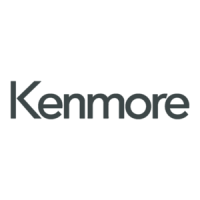
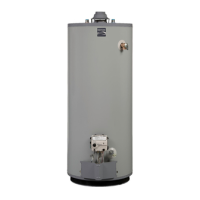



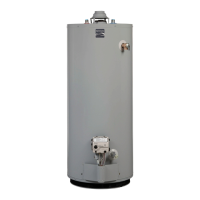
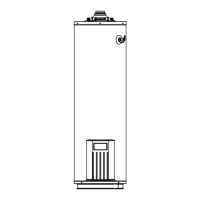
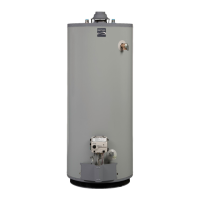

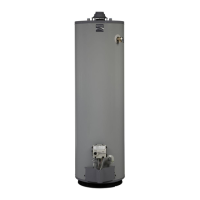


